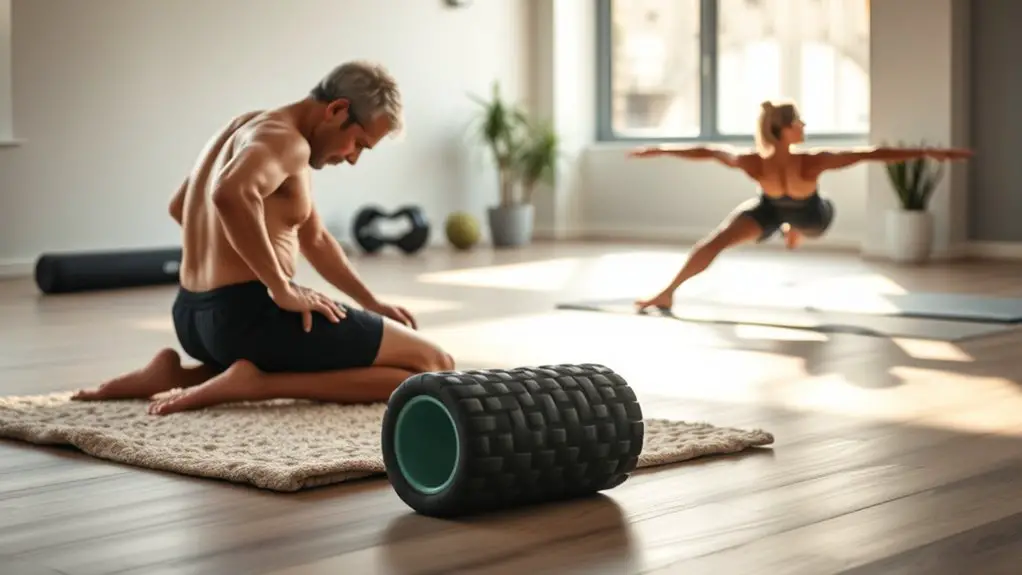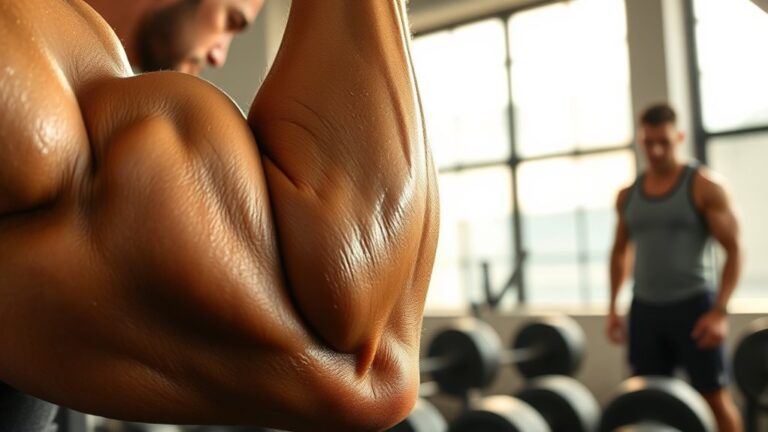Foam Rolling vs. Stretching: Which Is Better?

Foam rolling and stretching both have unique benefits for your workout routine. Foam rolling provides immediate pain relief and helps muscles recover, while stretching focuses on lengthening muscles and improving flexibility. Incorporating both techniques at appropriate times can enhance your performance and recovery. Foam rolling is great before and during workouts to ease tightness, while stretching is best afterward. If you’re curious about how to integrate these methods effectively, there’s more to explore.
Understanding Foam Rolling: Techniques and Benefits

Foam rolling is a popular self-myofascial release technique that can enhance your workout recovery. By using foam roller techniques, you can effectively target tight muscles and fascia, helping to alleviate soreness and improve flexibility. To get started, gently roll over areas like your calves, quadriceps, and back, pausing on any tight spots for 20-30 seconds.
It’s crucial to maintain proper form and avoid rolling directly over joints or bony areas to prevent injury. The muscle recovery benefits of foam rolling include increased blood flow to the muscles, which aids in nutrient delivery and reduces muscle stiffness. Incorporating foam rolling into your routine can lead to quicker recovery times and improved performance. Just remember to listen to your body; if something feels painful, ease up or consult a professional. Prioritizing safety while foam rolling will guarantee you reap all the recovery benefits without risking injury.
The Science Behind Stretching: Types and Advantages
While foam rolling has its benefits, stretching plays a crucial role in enhancing flexibility and overall performance. Understanding the types of stretching and their advantages can help you incorporate them effectively into your routine.
Stretching is essential for improving flexibility and performance, making it a vital addition to your fitness routine.
Here are three main types of stretching to reflect on:
- Static Stretching: This involves holding a stretch for a period, which helps lengthen muscles and improve flexibility. It’s best done post-workout to aid recovery.
- Dynamic Stretching: This consists of controlled movements that gently take you to the limits of your range of motion. It’s ideal for warming up before exercise, increasing blood flow, and preparing your body for activity.
- Proprioceptive Neuromuscular Facilitation (PNF): A more advanced technique that combines stretching and contracting muscles, benefiting flexibility and strength.
Comparing Effectiveness: Foam Rolling vs. Stretching

When considering ways to enhance your fitness routine, understanding the effectiveness of foam rolling compared to stretching is crucial. Foam rolling can provide immediate pain relief by targeting tight muscles and fascia, promoting blood flow and aiding muscle recovery. It’s especially beneficial after a workout, helping to reduce soreness and improve flexibility.
On the other hand, stretching focuses on lengthening muscles and improving overall range of motion. While it can also aid in muscle recovery, its benefits may not be as pronounced for immediate pain relief as foam rolling offers.
Ultimately, both techniques have their place in a well-rounded routine. If you’re seeking quick relief from discomfort, foam rolling might be your best bet. However, if you’re looking to enhance flexibility and prevent injuries, incorporating stretching is essential. Balancing both methods can help you achieve the best fitness and maintain safety in your training regimen.
When to Use Foam Rolling or Stretching in Your Routine
Incorporating foam rolling and stretching into your routine can greatly enhance your workouts, but knowing when to use each technique is essential. Here’s a simple guide to help you decide:
- Before your workout: Use foam rolling techniques to warm up your muscles and increase blood flow. This can help reduce the risk of injury and improve your overall performance.
- During your workout: If you start feeling tightness, consider quick foam rolling sessions to alleviate discomfort. This can keep you moving safely and effectively.
- After your workout: Shift to stretching routines to promote flexibility and help your muscles recover. This is vital for maintaining long-term mobility and preventing soreness.
Personalizing Your Approach: Factors to Consider

Choosing between foam rolling and stretching isn’t one-size-fits-all; it can depend on various personal factors. First, consider your individual goals. Are you looking to improve flexibility, relieve muscle soreness, or enhance recovery? Your objectives will guide your choice.
Next, think about the activity types you engage in regularly. If you’re involved in high-impact sports, foam rolling might help alleviate tension and improve muscle function. On the other hand, if you’re aiming for increased flexibility, incorporating static stretching can be beneficial.
Additionally, listen to your body. If you experience pain or discomfort while foam rolling, it may not be the right fit for you. Always prioritize safety and consult a healthcare professional if you’re unsure about the best approach for your unique situation. Tailoring your routine based on these factors can lead to more effective and enjoyable outcomes.
Frequently Asked Questions
Can Foam Rolling and Stretching Be Done Together?
Absolutely, you can do foam rolling and stretching together! Combining foam rolling benefits, like increased blood flow and muscle relaxation, with various stretching techniques can enhance your workout routine. Start with foam rolling to release tight muscles, then follow up with gentle stretches to improve flexibility. Just be sure to listen to your body and avoid pushing yourself too hard. This combination can lead to better recovery and overall muscle health!
How Long Should Each Session of Foam Rolling or Stretching Last?
Think of your muscles like a garden; if you water them too little or too much, they won’t thrive. For ideal duration, aim for about 10-15 minutes of foam rolling and stretching per session. You can do this 2-3 times a week, depending on your needs. Just like a well-tended garden, your muscles will flourish with the right care, ensuring you stay safe and avoid injury while enhancing flexibility and recovery.
Are There Any Risks Associated With Foam Rolling or Stretching?
When it comes to foam rolling or stretching, there are some risks if you don’t use proper technique. You might strain a muscle or aggravate an existing injury, which can hinder injury prevention efforts. It’s vital to listen to your body and avoid pushing through pain. Always start gently and gradually increase intensity. If you’re unsure about your technique, consider consulting a professional to guarantee you’re practicing safely and effectively.
What Equipment Do I Need for Foam Rolling?
When it comes to foam rolling, you don’t need much, but having the right equipment is key. A quality foam roller is essential, as it comes in various densities to match your comfort level. You might also consider a massage ball for targeted areas. Learning foam rolling techniques can maximize benefits while minimizing injury risk. Always listen to your body, and don’t hesitate to consult a professional if you’re unsure about your approach.
How Often Should I Incorporate Foam Rolling or Stretching Into My Routine?
When it comes to frequency recommendations, aim to incorporate foam rolling or stretching into your routine at least two to three times a week. This helps maintain flexibility and reduce muscle tension safely. If you’re particularly active or feeling sore, consider adding it daily. Just listen to your body—don’t overdo it, and modify based on how you feel. Consistency is key for ideal results without risking injury.





